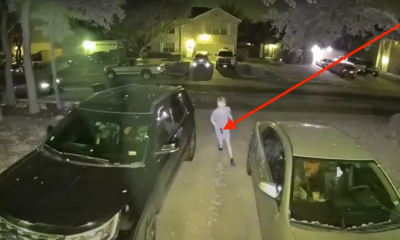Preparedness
Homeowner Defends Family Intruder Fatality Shocks Community

In the early hours of Friday, police in Hobbs, New Mexico, responded to a distress call regarding a break-in on the 2100 block of North Rojo. Hobbs, situated just two miles west of the Texas border and nearly two hours southwest of Lubbock, became the scene of a tragic incident.
Upon arrival, officers discovered that 38-year-old Curtis Thames had forcefully entered a residence. The homeowners, armed and seeking safety, barricaded themselves in a bedroom. As Thames approached, one of the homeowners fired a shot through the bedroom door, hitting Thames.
“Thames died at a local hospital,” police confirmed.
In an unsettling twist, officers were informed that Curtis Thames’ mother, Kristie Thames, lived in a neighboring home. Efforts to contact her proved futile, prompting officers to forcibly enter her residence. Inside, they found her deceased in a bedroom.
The police department’s news release on the incident does not include a cause of death for Thames’ mother.
Authorities are urging anyone with information about the incident to reach out. “Police said those who have information regarding the incident can call dispatch at 575-397-9265 or Lea County Crime Stoppers at 575-393-8005.”
The incident has sparked varied reactions on social media. One commenter stated, “This is why we have the 2nd Amendment.” Another expressed sympathy, writing, “Prayers to the people who had to make the decision … they probably didn’t want to ever have to make, the officers and other first responders who were involved, and the families and friends of those whose lives will be forever impacted.”
Concerns about legal repercussions were also voiced. “Hope the DA doesn’t charge the homeowner with manslaughter for defending himself,” one user remarked, noting the district attorney’s reputation for charging individuals who act in self-defense.
Another commenter praised the homeowner’s actions, saying, “Good job for the homeowner! Sounds like it was the last thing they wanted to do, but they were protecting their property and family.”
Let us know what you think, please share your thoughts in the comments below.

Preparedness
5 Things in Your Home That Can Help You Create a Safe Escape Plan

Not every dangerous moment involves a direct confrontation. Sometimes the real threat is confusion, panic, or not knowing what to grab when you need to react fast. Your home already has simple items that can help you stay oriented, stay calm, and get out safely if something goes wrong — whether it’s a break-in, a fire, or any unexpected emergency.
Here are five everyday things that can quietly strengthen your safety plan without feeling like “preparedness gear.”
1. A Pair of Shoes You Can Slip On Fast
This sounds almost too simple, but it’s one of the most overlooked safety tools in any house.
If you need to leave in a hurry — even just to get outside and call for help — you don’t want to waste time with laces or walk barefoot over broken glass, cold pavement, or debris. Keep a sturdy slip-on pair by your bed. It’s a small habit that can make a huge difference.
2. A Charged Old Phone
Even a disconnected phone can still call 911.
If you have an old smartphone in a drawer, charge it and leave it in your bedroom or a hidden spot. During an emergency, your main phone might be out of reach, dead, or taken. Having a backup gives you a second chance to call for help.
3. A Mini Flashlight on Your Nightstand
Power outages often happen at the worst moments. A small flashlight helps you see where you’re stepping, find your keys, or check on a noise without stumbling around in the dark. It also helps you avoid tripping hazards if you need to move quickly. Choose a compact LED one and keep it in the same spot every night.
4. A Loud Whistle
If you can’t shout, or your voice doesn’t carry far, a whistle can be your lifeline.
It cuts through walls, hallways, and even outdoor distance better than yelling. Whether you’re trying to alert a neighbor, scare off an intruder, or signal for help during a medical emergency, a whistle is one of the most underrated tools for personal safety.
5. A Written “Quick Escape Plan”
You don’t need blueprints — just a simple index card taped inside a drawer or next to your nightstand.
Write down:
• Your fastest exit routes
• Where your keys always stay
• Where your phone and flashlight stay
• A reminder to put on shoes
• Who to call first
In a panic, people forget steps. A small card keeps your mind focused and your actions clear.
Final Thought
Self-protection starts long before danger shows up. It’s not about preparing for a fight — it’s about preparing to move, think, and react in a way that keeps you safe.
Preparedness
5 Everyday Items in Your Home That Can Help You Protect Yourself

Most people don’t keep traditional self-defense tools around the house, but that doesn’t mean you’re helpless in an emergency. The truth is, you already own simple items that can give you precious seconds to get away, call 911, or draw attention. The key is knowing what works, what’s legal, and how to use these items only to defend yourself when you have no other choice.
Here are five practical household items that can help you stay safe during a threatening situation:
1. A Heavy-Duty Flashlight
A solid, metal flashlight is one of the best non-lethal tools you can keep within reach.
It serves two purposes:
• The bright beam can disorient someone long enough for you to escape.
• The sturdy body gives you something to hold if you need to keep distance between yourself and a threat.
Keep one by your bed and another near your front door.
2. A Loud Personal Alarm or Air Horn
Sometimes the strongest defense is noise. A personal alarm or small air horn can draw attention fast and frighten off an intruder. These devices are inexpensive, easy to use, and require no physical strength. They also alert neighbors that something is wrong, which can shorten response time dramatically.
3. A Strong Walking Cane
For older adults especially, a cane can be surprisingly effective for self-defense if absolutely needed. Its length helps you create distance, and its solid structure gives you a way to push someone back without having to get close. Even if you don’t use a cane daily, keeping one near your bedroom can be smart.
4. A Fire Extinguisher
Beyond its intended use, a fire extinguisher can help you defend yourself in two ways:
• The blast of spray can temporarily block vision and breathing, allowing you to escape.
• Its weight gives you something sturdy to hold while you retreat.
Plus, it’s already a safety essential for your home.
5. A Kitchen Pan or Lid
If you’re caught in the kitchen, a heavy pan or even a metal pot lid can create an effective barrier. A lid works like a small shield, helping you protect your face and upper body as you move away. A pan gives you something solid to hold between you and a threat.
A Final Note on Safety
Self-defense is always about getting away safely, not engaging in a fight. Your first options should always be:
• Avoid the situation
• Lock or barricade a door
• Call for help
• Get to safety
Use objects only as a last resort and only to give yourself time to escape.
Preparedness
5 Things You Should Always Carry During a Winter Storm

When a winter storm rolls in, life can shift fast. Roads freeze, power lines drop, and long errands suddenly become real risks. The good news is that a little preparation goes a long way, especially if you keep a few essential items within reach. These aren’t expensive or complicated. They’re simple, practical tools that can make all the difference when temperatures drop and help arrives slowly.
Below are five things worth carrying with you any time severe winter weather is in the forecast. Think of them as your personal insurance plan — small items that bring peace of mind in uncertain conditions.
1. A Fully Charged Portable Power Bank
If you’re stranded or delayed, your phone becomes your lifeline. It lets you call for help, follow weather alerts, and use GPS if you need to find your way. In cold weather, phone batteries drain much faster, so a reliable power bank is a must. Choose one that can charge your phone at least twice. Keep it in an inside pocket so cold temperatures don’t sap its power.
2. An Emergency Blanket
These lightweight, reflective blankets take up almost no space, but they retain an incredible amount of body heat. If your car breaks down or you get stuck outdoors, an emergency blanket helps you stay warm enough until help arrives. For older adults especially, preventing a rapid drop in body temperature is critical. Toss one in your glove box or day bag — you won’t notice it until you really need it.
3. High-Energy Snacks
In extreme cold, your body burns calories faster to stay warm. Carrying a small stash of calorie-dense snacks gives you steady energy and helps maintain body temperature. Look for items that won’t freeze rock-solid, such as nut butters, protein bars, granola, or trail mix. If you take medication that requires food, this becomes even more important.
4. A Compact LED Flashlight
Winter storms often come with poor visibility. Whether you’re navigating an icy path, checking under the hood, or signaling for help, a bright flashlight is worth its weight in gold. Choose an LED model with long battery life, and avoid relying solely on your phone’s flashlight. You may need that battery for communication.
5. A Small First-Aid Pouch
Accidents are more common when surfaces are slick. A small kit with bandages, antiseptic wipes, medical tape, hand warmers, and any personal medications can stabilize minor injuries until you can get proper care. Add a pair of disposable gloves to protect your hands in freezing weather.
Preparing for winter doesn’t mean living in fear. It simply means respecting the season and giving yourself the tools to stay safe, warm, and steady. With these five essentials on hand, you’ll be better equipped to handle whatever a winter storm throws your way — and you’ll travel with much more confidence as the temperatures fall.
-

 Tactical2 years ago
Tactical2 years ago70-Year-Old Fends Off Intruder with Lead-Powered Message
-

 Tactical2 years ago
Tactical2 years agoVape Shop Employee Confronts Armed Crooks, Sends Them Running
-

 Preparedness1 year ago
Preparedness1 year agoEx-Ballerina’s Guilty Verdict Sends Tremors Through Gun-Owner Community
-

 Off The Grid1 month ago
Off The Grid1 month ago10 Foods That Could Save Your Life When Grocery Shelves Are Empty
-

 Preparedness1 year ago
Preparedness1 year agoGood Samaritan Saves Trooper in Harrowing Interstate Confrontation
-

 Tactical2 years ago
Tactical2 years agoMidnight SUV Theft Interrupted by Armed Homeowner’s Retaliation
-

 Preparedness5 months ago
Preparedness5 months agoHow Much Gasoline Should You Store for Emergencies?
-

 Nature and Wildlife4 weeks ago
Nature and Wildlife4 weeks ago10 Survival Skills You Should Learn Before You Need Them
Don
September 27, 2024 at 2:29 pm
Trooper Duncan is lucky she is alive. It took forever for more troopers to get there.
Paul
September 27, 2024 at 5:11 pm
I think you’re a bit confused Don, there is no mention of any trooper in this article. Meanwhile back at the ranch, good for the homeowner, self protection is above everything, the lawyers and DA (dumbass) have their priorities wrong if they choose to charge them.
Bill Stephens
September 27, 2024 at 6:12 pm
I’m a bit confused myself. Who is in the picture of the guy who looks incarcerated, and why?
RobertC
September 27, 2024 at 9:25 pm
This srticle, and the comments that followed, bring about more questions than answers. Internet journalism increasingly sucks.